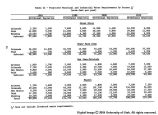| OCR Text |
Show PART I INTRODUCTION History People in the Upper Colorado River Basin have supported themselves principally by exporting the products of their farms and mines. The products have been shipped direct from the farm gate and the mine mouth, and offloaded at points outside the basin. Little handling or processing of the raw products has taken place in the basin. This has limited population, market, and industrial concentration within the basin; and consequently, the need for water for municipal and industrial purposes. Lack of water is generally not considered to have constrained urban or industrial development in the basin. Planning for domestic, municipal, and industrial water supply was historically secondary in the Region to planning for irrigation. The locations of most of the settlements which have become today's towns and cities were influenced by farmers having the primary objective of locating as near as possible to an irrigation water supply. In many instances, the water needed to meet a settlement's domestic requirements was hauled or conveyed by other means from distant springs or creeks, since the quality of the irrigation water supply was not suitable for household use. In some rural and Indian reservation areas, domestic water is still hauled. In still a few other rural areas, individual home storage cisterns for household water are filled direct from irrigation canals. Government agencies responsible for planning and constructing water supply projects in the Upper Colorado Region have only recently included development of municipal and industrial water supplies as a project purpose. Of the last nine Bureau of Reclamation projects authorized for construction in the Region (all participating projects of the Colorado River Storage Project), six include plans to develop water for municipal and industrial uses, largely, to meet anticipated demands perhaps a decade or more away* The development and distribution of water for domestic and municipal uses was one of the first services provided in settlements after they became established. Many of the settlements became incorporated to faci- litate the financing of municipal water supply systems. The early systems were comparatively simple. Many have not changed over the years; while others, particularly those serving larger towns and cities, have been improved by addition of metering equipment, treatment plants, pressure stations, etc. Soon after the Federal Government became the trustee for the Indians, development and improvement of surface and ground water supplies in Indian areas was undertaken. Numerous springs, wells, and ponds were developed for livestock water. Many of these have been modified to also supply domestic water. The municipal water supply systems on reservation lands have been developed by federal and state agencies, private businesses, and by the Indian tribes. In many instances, systems developed by these |

















































































